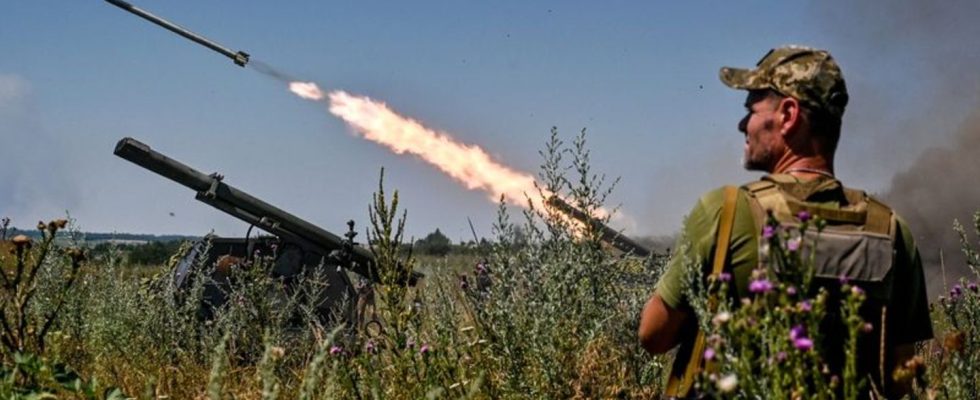The Ukrainian counter-offensive in the south of the country has turned into a battle of attrition. Instead of a quick breakthrough at the front, every meter is fought for.
Huge explosions shook the south-east of the Crimean Peninsula, annexed by Russia since 2014. A huge ammunition depot near the port city of Feodosiya has been burning for days.
The four adjacent villages had to be evacuated. While the occupation authorities are officially silent on the causes, Russian military bloggers report that the Ukrainians set fire to the arsenal with rockets.
The explosions will “continue for a long time and not only in this facility, because we announced the “bang” season, we are continuing it, we are watching with undisguised joy as it “blossoms”,” spokeswoman for the Ukrainian Army South Command Natalya Humenyuk indirectly confirmed Kiev’s involvement in it. There is speculation as to whether Kiev used the British Storm Shadow missiles or the home-made Hrim-2 for the attack.
Slow pace
The attack targets the logistics of the Russian troops in the rear. The ammunition depot under attack is more than 200 kilometers from the front. The fact that Kiev is now increasingly relying on this element again around seven weeks after the start of the Ukrainian counter-offensive also shows that progress in the combat zone is not progressing as quickly as the Ukrainian leadership and many Western military experts had hoped.
According to Deputy Defense Minister Hanna Maljar, the Ukrainians have liberated 210 square kilometers of their own soil since the beginning of June. For comparison, Russia occupies more than 100,000 square kilometers of Ukrainian territory, including Crimea.
At this rate, recapturing all areas would take more than 60 years – and Maljar has probably not even counted the small territorial gains that the Russians made in northeastern Ukraine at the same time.
Mines are considered a problem
The Ukrainians are slowed down by extensive minefields guarded by artillery and well-entrenched infantry. Drones illuminate the battlefield. Russian helicopters fire missiles at approaching armored vehicles.
Pictures of burning tank columns at the beginning of the offensive showed that attempts to break through the front line with fast equipment had failed. According to western experts, up to 50 percent of the delivered Leopard 2 tanks are damaged or destroyed.
Due to many technical failures in the first few weeks, the Ukrainian military has changed tactics and is now relying on small infantry squads, which use the armored personnel carriers as a kind of taxi to the minefields. There they dismount, try to clear the way under the protection of their own artillery and fight their way to the enemy lines in small leaps. If one group fails, the next one is brought in.
The mines remain a major problem. A drone video of the 47th brigade distributed by the Ukrainian military correspondent Yuriy Butusov showed the difficulties at the end of June: A group of soldiers, some of whom had already been injured by mines, were stuck in an open field. Burnt-out armored personnel carriers and black detonation marks can be seen. Survivors crawl onto the rescue tailgate of a Bradley armored personnel carrier.
The video also shows: Others stay behind on the field for the time being. Another Bradley infantry fighting vehicle drives up to help transport the wounded. Several mines explode. A soldier loses his right leg after jumping onto a mine. You can clearly see how he quickly binds the wound. Dragging the bloody remains of his leg, he saves himself in the infantry fighting vehicle.
After a violent storm of indignation on social media, Butusov deleted the video. But it also showed what sacrifices the counter-offensive demands of the Ukrainian soldiers.
The trench warfare enforced by the minefields robs them of their greatest advantage in war: mobility. Instead, the Ukrainians are moving slowly and methodically. Artillery fire on their infantrymen, Kiev’s forces responded by shelling the enemy positions exposed. Against a rested and well-equipped opponent, a frontal attack would have little chance of success. The defenders have the advantage.
Problems also on the Russian side
But the Russians have their own problems, starting with leadership. Kremlin chief Vladimir Putin started his war of aggression 17 months ago with too few troops in complete hubris. After the defeats in the fall, Moscow was forced to rush into partial mobilization. Despite this, what it says is “the second strongest army in the world” is outnumbered in many sectors of the front.
The complaint by General Ivan Popov of the 58th Army fighting in Zaporizhia led to a scandal: their own troops lacked artillery reconnaissance and, above all, rotation to give worn-out units the opportunity to recover and replenish. As a “scaremonger” he was fired by the general staff.
But even Russian military observers confirm Popov’s criticism. The units are severely depleted and overloaded. The supply is inadequate – also because the supply routes are repeatedly shot at. Only in the next two to three weeks will it become clear which side will run out of reserves first. It is quite possible that the Ukrainians will eventually lose their strength.
If they succeed in breaking through at one point, a deep advance is possible. So far, they have reportedly deployed just under a third of their Western-equipped and Western-trained troops into combat.
Outgoing US Chief of Staff Mark Milley estimated the counteroffensive to take about ten weeks. The Ukrainian army leadership should therefore be able to show results by Independence Day on August 24 at the latest.

